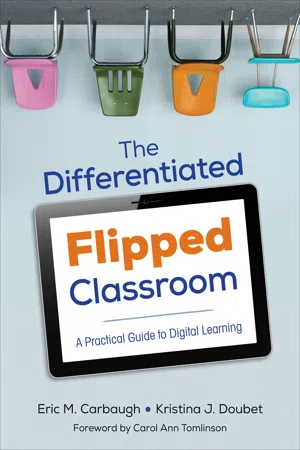
The Differentiated Flipped Classroom
A Practical Guide to Digital Learning
- 216 pages
- English
- ePUB (mobile friendly)
- Available on iOS & Android
The Differentiated Flipped Classroom
A Practical Guide to Digital Learning
About this book
Ensure personalized student learning with this breakthrough approach to the Flipped Classroom!
In the flipped classroom, students need to do more than simply re-watch a video to learn effectively. This groundbreaking guide helps you identify and address diverse student needs within the flipped classroom environment. You will find practical, standards-aligned solutions to help you design and implement carefully planned at-home and at-school learning experiences, all while checking for individual student understanding.
Learn to differentiate learning for all students with structured, research-based best practices to help you:
- Integrate Flipped Learning and Differentiated Instruction
- Use technology as a meaningful learning tool
- Implement flexible planning and grouping
- Proactively use ongoing formative assessments
- Adjust instruction to support, challenge, and motivate diverse learners
- Manage the Differentiated Flipped classroom
Includes practical examples and a resource-rich appendix. Make your flipped classroom a true place of learning with this go-to guide!
"The expectations for teaching in today's world are steadily increasing. Students expect their teachers to use technology in instruction. Parents and administrators expect teachers to differentiate instruction to reach every student. In this book you will learn how both models can work in concert. Even more importantly you will learn many practical strategies that will allow you to meaningfully differentiate your instruction while flipping your classroom, allowing you the greatest potential to reach all of your students."
—David A. Slykhuis, PhD, President of SITE (The Society for Information Technology and Teacher Education)
Frequently asked questions
- Essential is ideal for learners and professionals who enjoy exploring a wide range of subjects. Access the Essential Library with 800,000+ trusted titles and best-sellers across business, personal growth, and the humanities. Includes unlimited reading time and Standard Read Aloud voice.
- Complete: Perfect for advanced learners and researchers needing full, unrestricted access. Unlock 1.4M+ books across hundreds of subjects, including academic and specialized titles. The Complete Plan also includes advanced features like Premium Read Aloud and Research Assistant.
Please note we cannot support devices running on iOS 13 and Android 7 or earlier. Learn more about using the app.
Information
Chapter 1 Flipping and Differentiating Finding Common Ground
- A Teacher in Action
- Flexibility—Both a Blessing and a Curse
- Overview of a Flipped Classroom
- Brain Research and the Flipped Classroom: Implications for Practice
- Knowledge
- Processing Opportunities
- Community
- Overview of a Differentiated Classroom
- Personalization and Differentiation
- Brain Research and the Differentiated Classroom: Why Differentiation Matters
- Knowledge-Centered
- Assessment-Centered
- Learner-Centered
- Community-Centered
- Differentiating and Flipping: A Harmonious Match
A Teacher in Action
Flexibility—Both a Blessing and a Curse
Overview of a Flipped Classroom
A pedagogical approach in which direct instruction moves from the group learning space to the individual learning space, and the resulting group space is transformed into a dynamic, interactive learning environment where the educator guides students as they apply concepts and engage creatively in the subject matter. (Yarbro et al., 2014, p. 5)
Brain Research and the Flipped Classroom: Implications for Practice
Knowledge
Processing Opportunities
Community
Overview of a Differentiated Classroom
Table of contents
- Cover
- Half Title
- Acknowledgements
- Title Page
- Copyright Page
- Contents
- Illustration List
- Foreword
- Acknowledgments
- About the Authors
- Preface
- Chapter 1 Flipping and Differentiating Finding Common Ground
- Chapter 2 Crafting and Maintaining a Positive Learning Environment Community and Mindset
- Chapter 3 Using Formative Assessment to Check for Understanding
- Chapter 4 Differentiating According to Student Readiness
- Chapter 5 Differentiating According to Student Interest and Learning Profile
- Chapter 6 Managing the Differentiated Flipped Classroom
- Chapter 7 Closing Thoughts
- Appendix A: Resources for Implementing a Flipped Classroom
- Appendix B: Sample Student Technology Survey and School District BYOD Policy
- Appendix C: Interest and Learning Profile Task Examples
- Appendix D: Extended Management Example
- Appendix E: Differentiated Flipped Lesson Plan (FLP) Template and Sample Lessons
- References
- Index
- Publisher Note